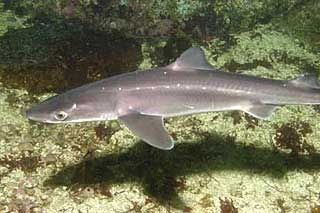Fish: Spiny Dogfish

Description
The Spiny Dogfish is a type of small shark and one of the best known of the dogfish. There are actually several species to which the name is applied, but all are readily distinguished by their having two spines, one in front of each dorsal fin, and their lack of an anal fin. They are members of the family Squalidae in the order Squaliformes.
The most widespread of the spiny dogfish is the grey-speckled Squalus acanthus, the common spiny (or piked) dogfish, which is found in shallow waters in most parts of the world. It can grow to around 60 cm in length and weighs about 2-3 kg. It particularly prefers temperate waters and migrates seasonally to find water of a comfortable temperature. It feeds on small fish and invertebrates, and can be present in such great numbers that it can seriously impact commercial fisheries. Spiny dogfish are themselves fished for food in Europe. In England, where they are particularly popular, they are often referred to as "woof". They are also somewhat euphemistically known as "rock salmon" or "rock eels".
Status: Classified as Lower Risk – near threatened (LR/nt) over the whole of its range on the IUCN Red List 2004.



1 Comments:
I'm not sure exactly, but the following organisations (for example) are involved in the conservation and protection:
"CITES (the Convention on International Trade in Endangered Species of Wild Fauna and Flora) is an international agreement between Governments. Its aim is to ensure that international trade in specimens of wild animals and plants does not threaten their survival." http://www.cites.org/
"IUCN - The World Conservation Union, through its Species Survival Commission (SSC) has for four decades been assessing the conservation status of species, subspecies, varieties and even selected subpopulations on a global scale in order to highlight taxa threatened with extinction, and therefore promote their conservation." http://www.redlist.org/
By Daldianus, at 11:26
Daldianus, at 11:26
Post a Comment
<< Home